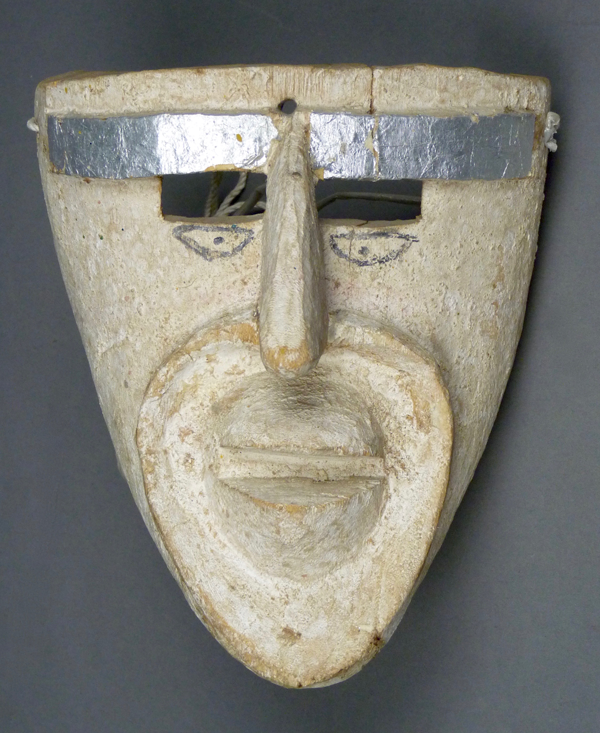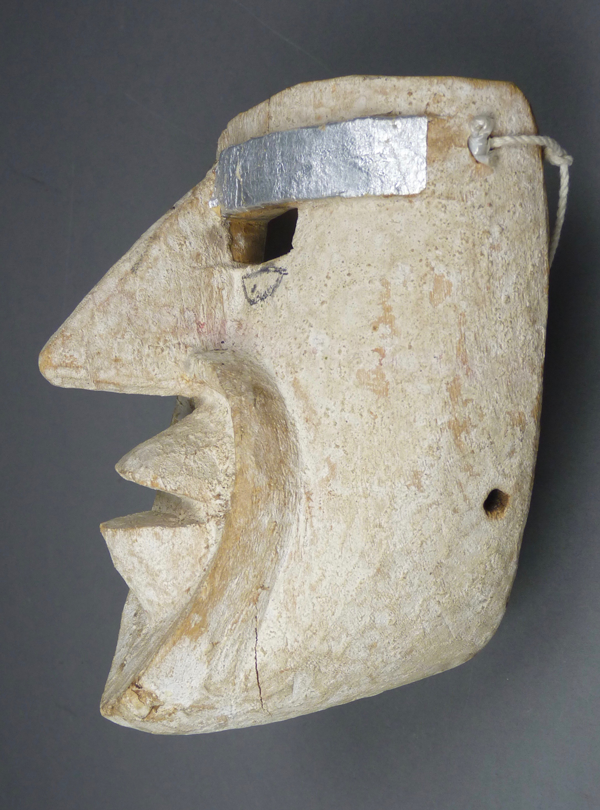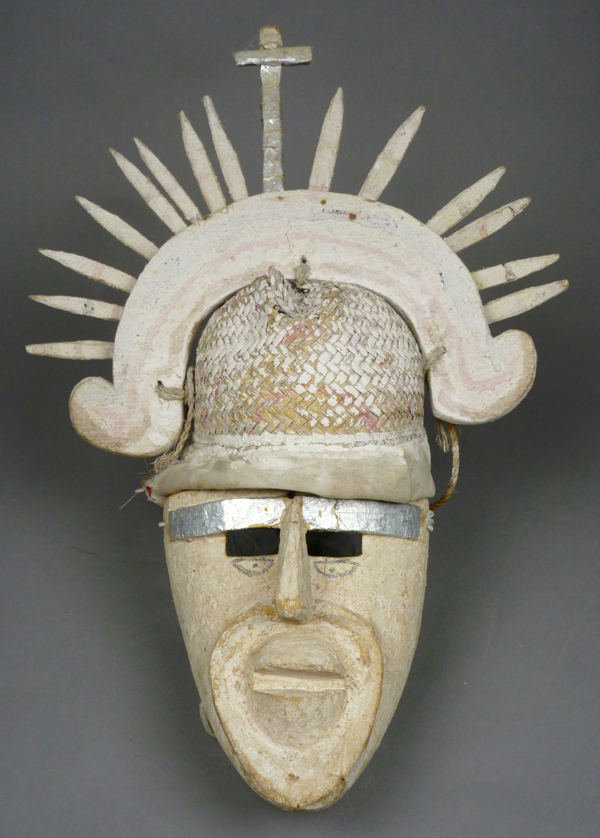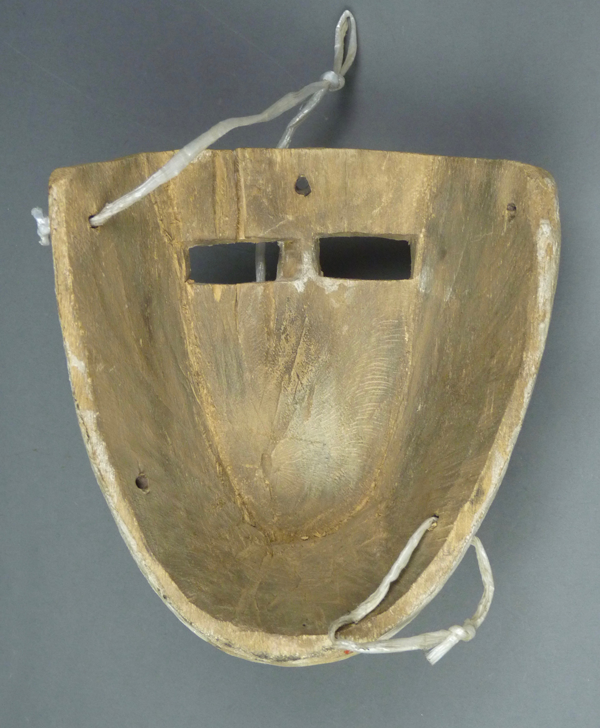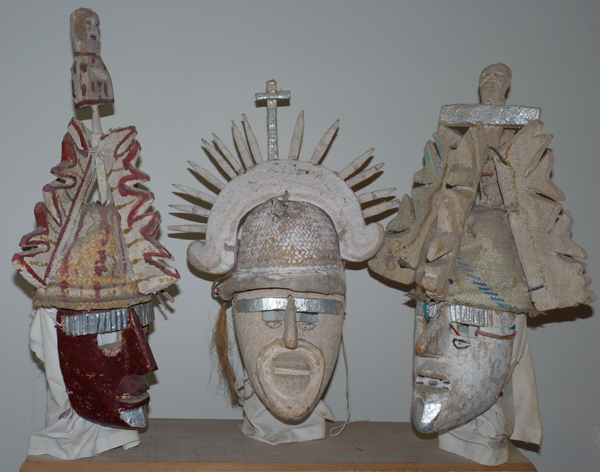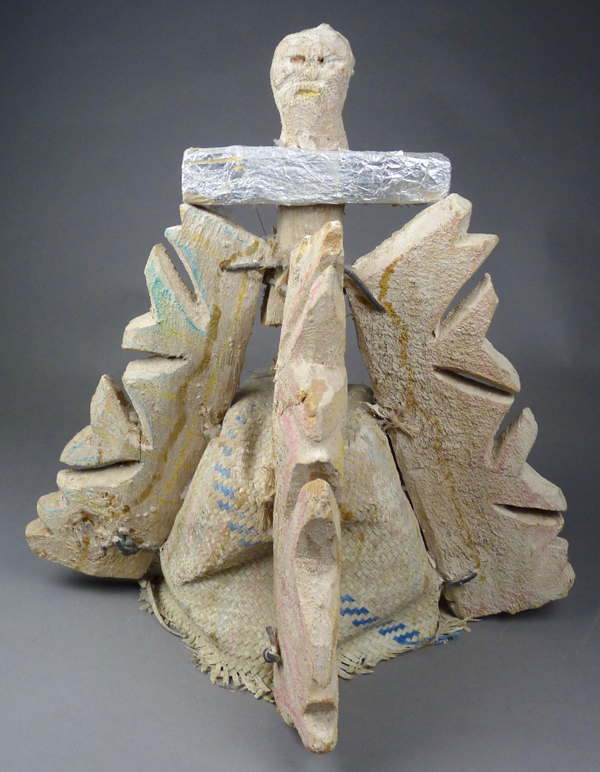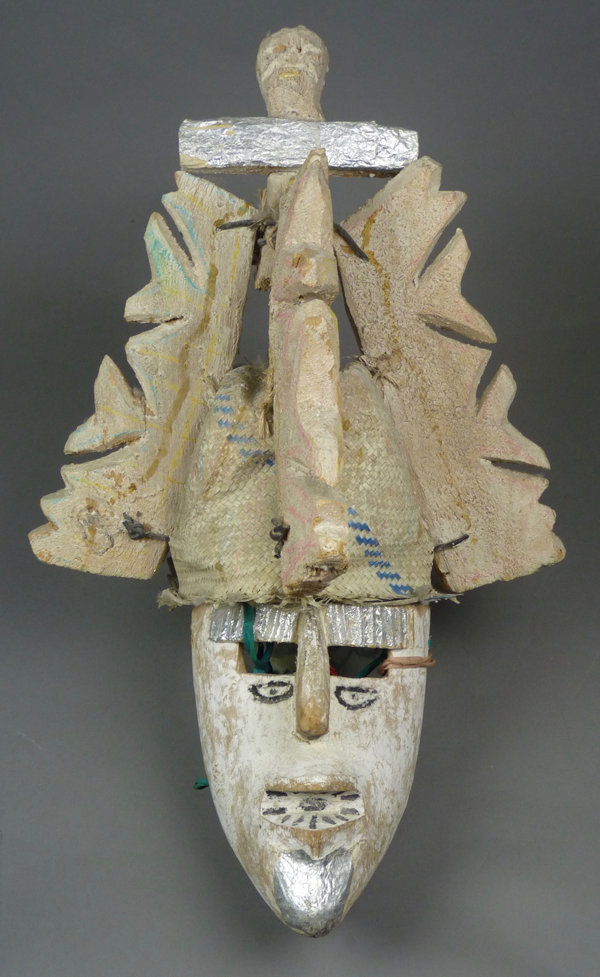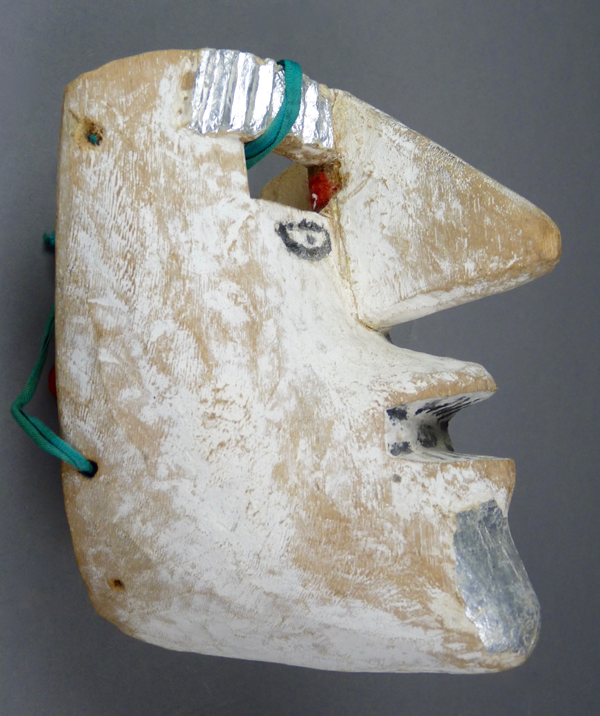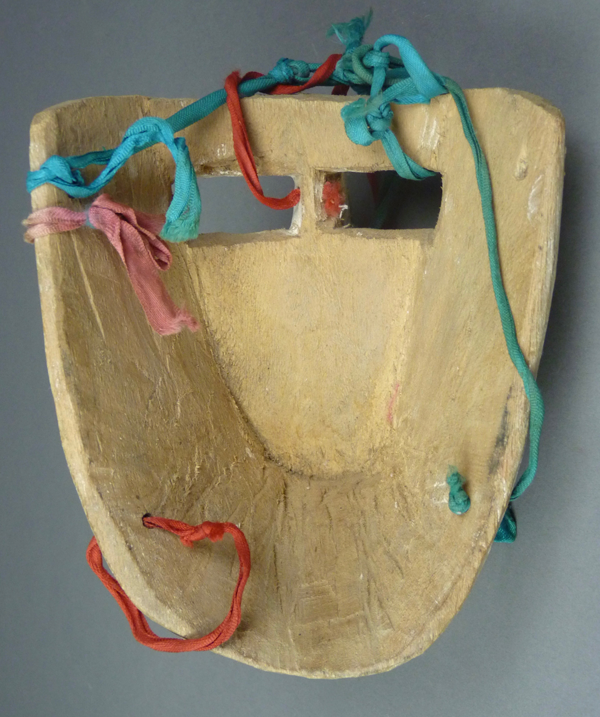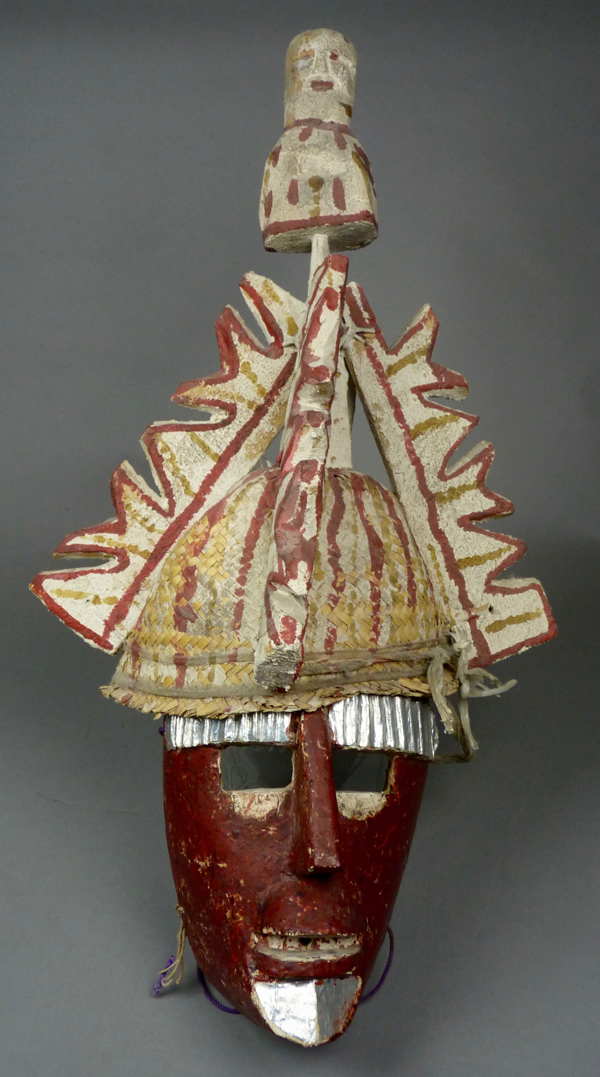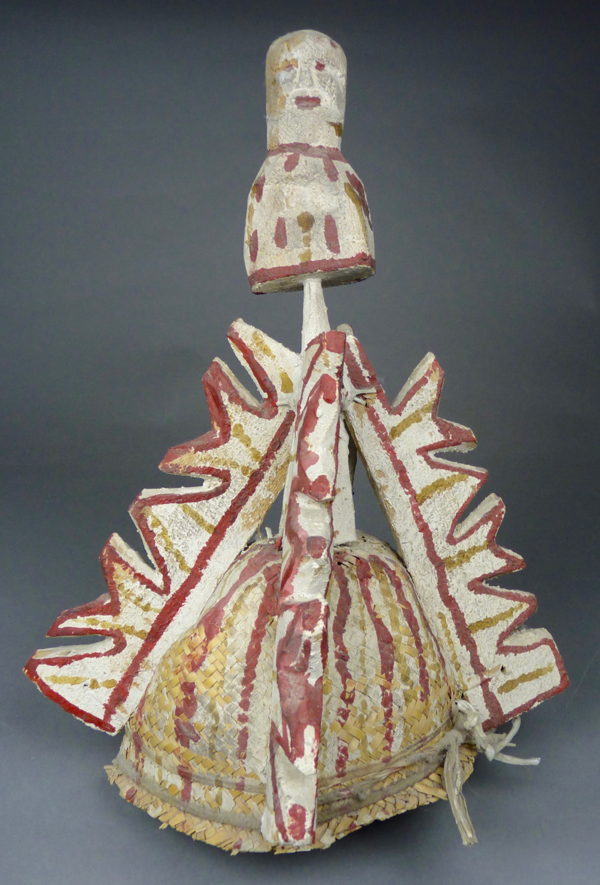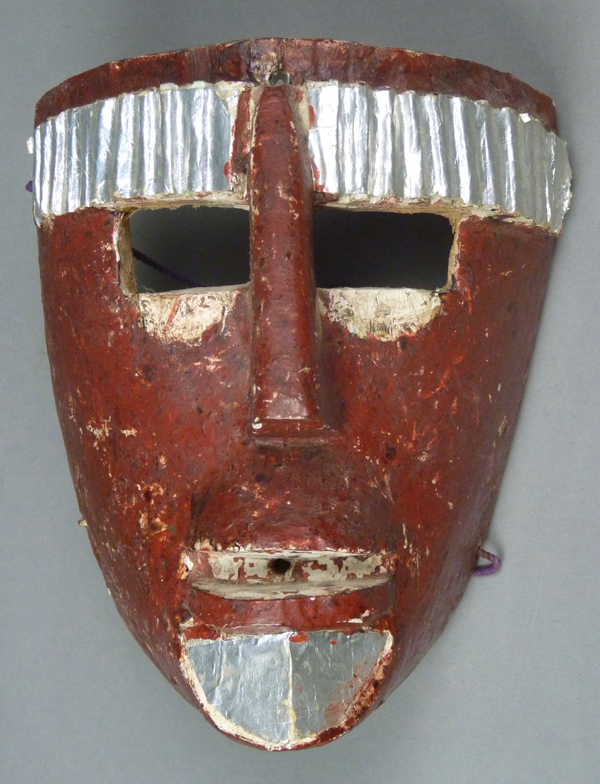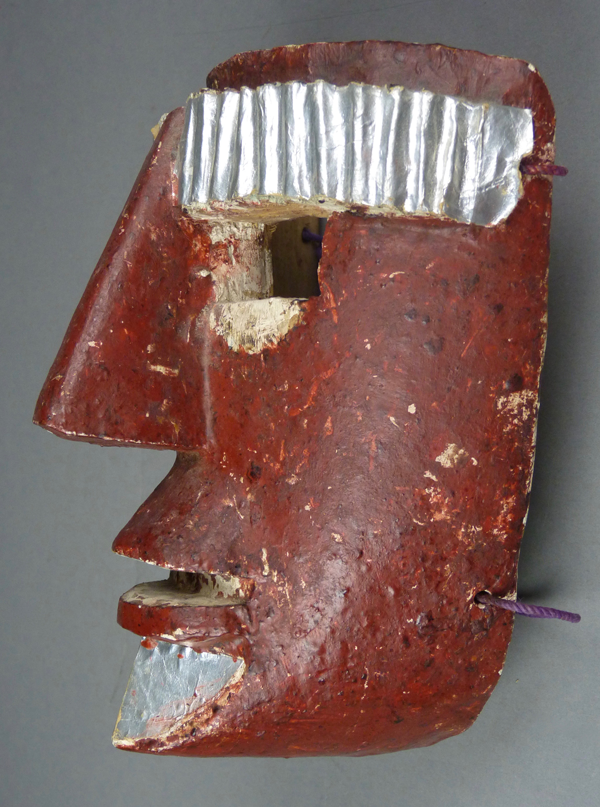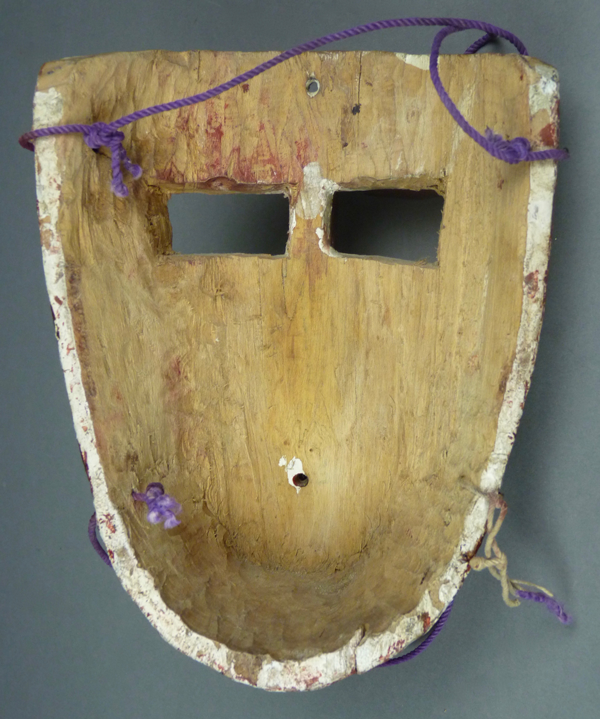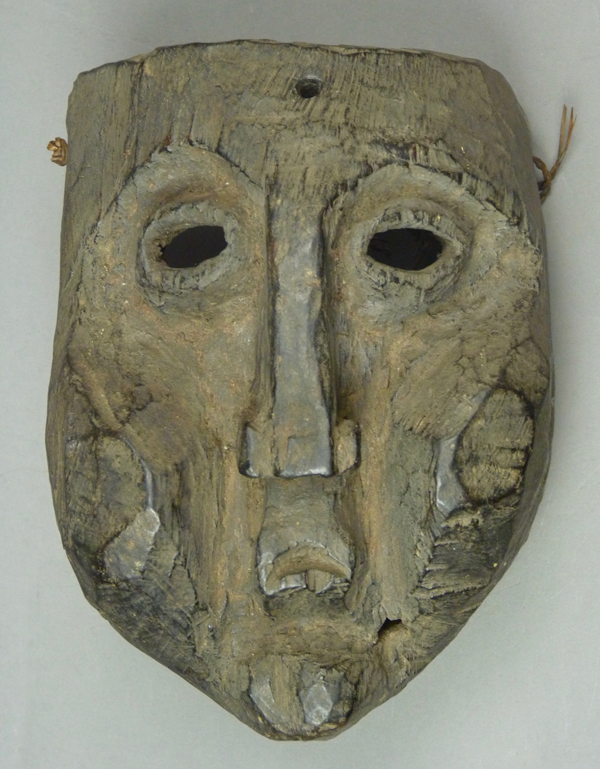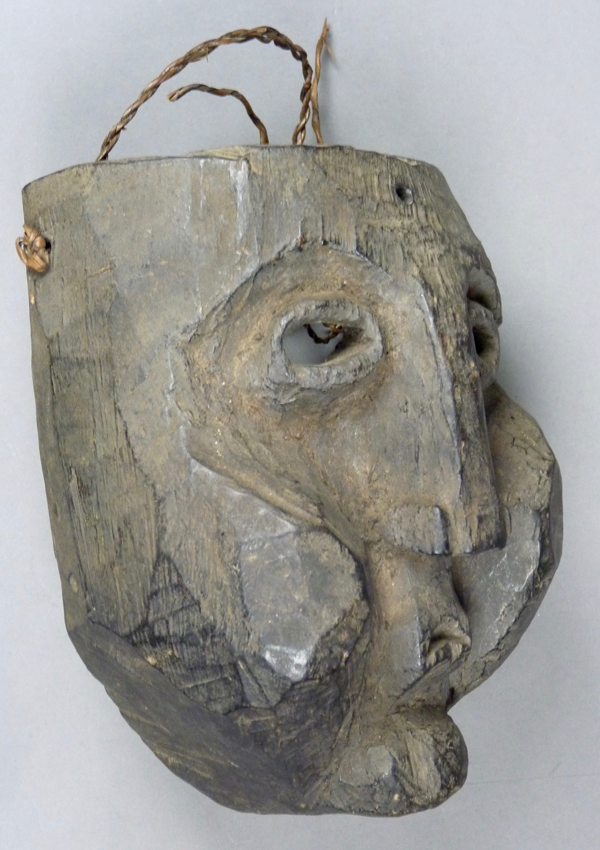Donald Cordry introduced many collectors to Archareo (archer)masks in his well known book, Mexican Masks (1981, pp 232-4). The Archareos perform a variation of the Conquest dance, which is of course itself modeled on the Moros y Cristianos. All these dances have the common theme of Spanish Christians versus some opponent, such as Moorish outsiders or indigenous peoples.
Victor José Moya Rubio included two Archareo traditional wooden masks and headdresses, one from Colotepec and the other from Pueblo Viejo, in Máscaras: La Otra Cara de México/ Masks: The Other Face of Mexico, Plates 54 and 55, on page 63. He also showed Archareo masks from San Martin Teotihuacan, in the State of Mexico, where Santiago wears a mask cast in lead and the Archareos wear masks made from painted and folded felt hats. A beautiful Archareo mask with headdress from Pueblo Viejo, Guerrero decorates the cover of El Tierra y El Paraíso, a catalogue of masks in the collection of Rafael Coronel (1993, pp. 20-21). In Changing Faces: Mexican Masks in Transition,on page 69 (plate 102) there is a classic Red-faced Archareo mask that has been paired with the white headdress of Santiago or one of the Christians (provenance unknown), and on page 59 there is another of those Santiago masks cast in metal. These metal masks include headdress elements that are part of the casting. Here is a link to a photo of a mask in this metal style. This mask, however, is virtually identical to another in Mask Arts of Mexico, by Ruth Lechuga and Chloë Sayer, plate 96 on page 69, which the authors state is constructed from fiberglass and resin, plus tin for the headdress.
https://www.flickr.com/photos/citlali/7658503434
Today I will share three traditional wooden Archareo masks like the one from “Cacalotepec” in Cordry, the ones from Pueblo Viejo in La Tierra y El Paraíso, and those in Moya Rubio’s book, along with three headdresses. These masks and headdresses were collected in Guerrero by a picker or “runner” for Robin and Barbara Cleaver. I am uncertain whether the runner had recorded which mask went with which headdress. It seems obvious that the white “Christian” masks would have been worn with white headdresses bearing a cross and the red Moro masks would be worn with other headdresses that lacked a cross. It only later became apparent to me that there was variety in the white masks and their headdresses.
In May, 1988, Robin and Barbara Cleaver had sold me a handsome pair of Archareo masks, one a white faced Christian mask with a headdress topped by a cross, and the other a maroon mask with no cross on the headdress. Here is the white mask.
In the years that followed, I compared this mask to a few other Archareo Christian masks from this area, and realized that mine was unusual, in that it had an oval goatee that framed the usual snouted mouth. Indeed, it has an elegant abstract goatee; I never saw another one like it, over nearly 30 years time. I concluded that this mask, bearded among so many that are beardless, might represent Santiago. To state this in another way, Mexican Santiago masks in general usually have beards, while most Archareo masks do not.
This beard has a low profile. The mouth, which resembles a bird’s beak, is of the same design as those on the other two masks that follow.
This one came with a headdress that had a human figure on top, that figure lacked arms, but a crossbar transformed this figure into a living cross. So this was a logical pairing—a Christian wearing a Christian headdress. An image of that headdress follows the group photo below.
Four years later I had the opportunity to buy another Christian Archareo mask from Joe Carr (then of Santa Fe) that he had purchased from the Cleavers. A photo of that mask also follows.
That Christian mask came with a headdress with multiple wooden spikes, which symbolized rays of light, a proper traditional design worn by Santiago in the Sierra de Puebla, and not unlike the tops of the cast metal masks of Santiago that are used in San Martín Teotihuacan, Mexico. Because Joe Carr had purchased this pair from the Cleavers, I assumed that all these objects had been part of the original group. I concluded that I probably had the right headdresses for my three masks, but two of them were accidentally assigned to the wrong masks.
I chose to display this Santiago style headdress on the Santiago mask.
The spiked headdress is 11½ inches tall.
Actually I am simplifying the account slightly. When I theorized that this style of headdress was necessary for Santiago, I asked the Cleavers what else they had in storage, and I was handed a cardboard box filled with headdresses in this style. The picker had gathered up whatever was available, seemingly without much thought of which headdress was worn with which mask. Most had arches cut from Masonite™, and then there was this one with a carved wooden arch. The Cleavers generously made an exchange. I thought it possible that this pair was originally together, 40 or 50 years ago. Perhaps the Masonite ones were later supplied to other Christian figures.
The Santiago mask is 7½ inches tall, 6 inches wide, and 4½ inches deep.
Here is the back of the Santiago mask. It is heavily stained from long use.
This was all well and good, but in preparing this post I have found a really good Youtube™ video of “Chareos” (Archareos) performing in Colotepec, Guerrero in 2017. Please look at this video; it is a gem.
https://www.youtube.com/watch?v=Lvn_fe1wQ7k
In this video at least two dancers with white-faced masks do wear the spiked headdress, while four dancers wear bearded white faced masks like the one above, but paired with cloth conical hats, for example at 1 minute and 4 seconds or at 3 minutes and 25 seconds. Other dancers with white faces wear cowboy hats. It is the Moros who wear the conical headdress made of four wooden pieces tied to the crown of an old hat. Once again, as with the Santiagueros, there are all these subgroups. I do not see corrugated eyebrows like those on two of my masks. Possibly much has changed over the 30 years since my masks were collected.
I want to say a little more about the Archareo masks in the Cordry book. On the one hand, Cordry was the first to publish a good photo of an authentic Archareo mask and headdress. However this introduction was marred by additional Archareo information that was erroneous. Cordry was told that two elaborate and impressive masks (plate 286, page 233) were Archareos or Alchileos (archers) from San Martín Pachivia. These were large helmet masks, 50 and 53 cm. tall (about 20 inches)! Cordry compared these to two “Alchileo” masks from Cacalotepec, Guerreo (really Colotepec). Those masks were accompanied by separate headdresses, one surmounted by a carved wooden bird and the other (not shown in the book) by a carved tigre (jaguar). These latter masks seemed to Cordry rather primitive and not as old as the first pair. However, experts now agree that the masks attributed to San Martín Pachivia are invented decorative masks, while those from Cacalotepec are the traditional Archareo masks. They were just 6 inches tall, but 18 inches tall with the headdress.
Returning to today’s trio, here is how I had ended up displaying these three masks. If I exchanged the headdresses on the two white masks, then they would be as I received them.
The one on the right is the Christian mask that I got from Joe Carr in 1992.
I assigned it the more generic Christian headdress that was previously paired with the mask I now call Santiago. I don’t imagine that this was could have been worn by a Moro, because of the cross.
Four carved slabs of wood have been attached to the woven crown of a hat and to a central post bearing a carved figure. This headdress is 13 inches tall.
Here is that combination up close.
The side view of the Christian mask follows.
This mask is 6½ inches tall, 5½ inches wide, and 4½ inches deep.
The strap of this mask was constructed from colorful strips of recycled cloth. The back is moderately stained from use.
The second mask that I originally bought from Robin and Barbara Cleaver continues to seem very well matched with the second style of headdress—the Moro style, which lacks a cross. This is the sort of mask and headdress that is in Cordry’s book.
In this case the headdress is capped with a human torso that closely resembles the one on the Christian mask, but it lacks the arms of a cross. Otherwise the construction of the two hat styles is identical. More broadly, these masks and headdresses share a number of generic elements, while it seems the Santiago mask and headdress can be distinctly different.
This headdress is 15 inches tall.
Silver foil from cigarette packaging was used to decorate eyebrows and goatees.
This mask and the Christian mask from Joe Carr’s collection share a highly attractive feature— eyebrows with carved corrugations. The hole in the mouth of this mask communicates with the back wall, serving as a limited breathing passage. The other two masks lack this feature. In passing, note that none of these masks have ears.
I really like the patina on this face. The paint on the eyes is really faded.
This mask is 7¼ inches tall, 5½ inches wide, and 4 inches deep.
The back is moderately stained from use.
I have another mask from Colotepec. Although it is clearly not an Archareo, it does seem to be a Moro, with a Moor’s frowning mouth. I have not found a mask like this in any video. When I purchased this mask from Jaled Muyaes and Estela Ogazón, Jaled pointed out that Colotepec is an Afro-Mestizo town. In the video of the Archareos we saw that the people from Colotepec have medium brown complexions, while this mask portrays a person whose skin is much darker than that. I mention this to recall that one seldom finds Mexican masks that closely resemble those who wear the masks. Rather it seems that masks generally represent someone else, some other, which permits the wearer to assume an identity not his own, whether obvious or covert. Superficially a mask might portray a Moor, for example, but frequently there is a second hidden meaning, such as that the Moors are secretly the Spanish. So one class can be openly mocked but covertly one is mocking someone else. The Afro-Mestizos of the Pacific coast of Oaxaca and Guerrero like Negrito masks, apparently for such purposes. Here is this dark Moro.
This is a primitive mask, which is why I like it. It is carved from dense dark wood. Actually much of the face seems to have been hewn with a machete and then left in that rough state.
This mask is 7½ inches tall, 5½ inches wide, and 3½ inches deep.
The back does demonstrate differential staining from use, and the strap is hand twisted twine.
Next week we will look carefully at just one unusual, rare, and old Moro mask. Two weeks from now we will consider a few additional Moors, including one said to be another Archareo from Guerrero, although it resembles the more traditional Moro masks of recent weeks.
Bryan Stevens

